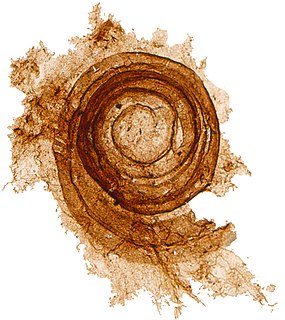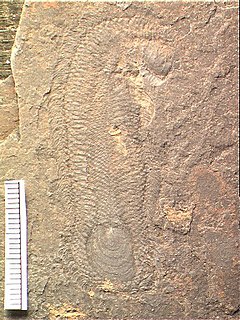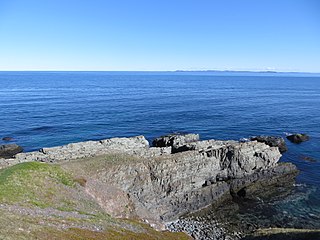Related Research Articles

The Chaetognatha or chaetognaths are a phylum of predatory marine worms that are a major component of plankton worldwide. Commonly known as arrow worms, about 20% of the known Chaetognatha species are benthic, and can attach to algae and rocks. They are found in all marine waters, from surface tropical waters and shallow tide pools to the deep sea and polar regions. Most chaetognaths are transparent and are torpedo shaped, but some deep-sea species are orange. They range in size from 2 to 120 millimetres.
The cloudinids, an early metazoan family containing the genera Acuticocloudina, Cloudina and Conotubus, lived in the late Ediacaran period about 550 million years ago. and became extinct at the base of the Cambrian. They formed millimetre-scale conical fossils consisting of calcareous cones nested within one another; the appearance of the organism itself remains unknown. The name Cloudina honors the 20th-century geologist and paleontologist Preston Cloud.

Conodonts are an extinct group of agnathan (jawless) vertebrates resembling eels, classified in the class Conodonta. For many years, they were known only from their tooth-like oral elements found in isolation and now called conodont elements. Knowledge about soft tissues remains limited. They existed in the world's oceans for over 300 million years, from the Cambrian to the beginning of the Jurassic. Conodont elements are widely used as index fossils, fossils used to define and identify geological periods. The animals are also called Conodontophora to avoid ambiguity.

Microdictyon is an extinct armoured worm-like animal coated with net-like scleritic plates, known from the Early Cambrian Maotianshan shale of Yunnan China and other parts of the world. Microdictyon is part of the ill-defined taxon – Lobopodia – that includes several other odd worm-like animals that resembling worm with legs, such as Hallucigenia, Onychodictyon, Cardiodictyon, Luolishania, and Paucipodia. The isolated sclerites of Microdictyon are known from other Lower Cambrian deposits. Microdictyon sclerites appear to have moulted; one sclerite seems to have been preserved during ecdysis.

A microfossil is a fossil that is generally between 0.001 mm and 1 mm in size, the visual study of which requires the use of light or electron microscopy. A fossil which can be studied with the naked eye or low-powered magnification, such as a hand lens, is referred to as a macrofossil.

The halkieriids are a group of fossil organisms from the Lower to Middle Cambrian. Their eponymous genus is Halkieria, which has been found on almost every continent in Lower to Mid Cambrian deposits, forming a large component of the small shelly fossil assemblages. The best known species is Halkieria evangelista, from the North Greenland Sirius Passet Lagerstätte, in which complete specimens were collected on an expedition in 1989. The fossils were described by Simon Conway Morris and John Peel in a short paper in 1990 in the journal Nature. Later a more thorough description was undertaken in 1995 in the journal Philosophical Transactions of the Royal Society of London and wider evolutionary implications were posed.
The Chancelloriids are an extinct family of animal common in sediments from the Early Cambrian to the early Late Cambrian. Many of these fossils consists only of spines and other fragments, and it is not certain that they belong to the same type of organism. Other specimens appear to be more complete and to represent sessile, bag-like organisms with a soft skin armored with star-shaped calcareous sclerites from which radiate sharp spines.
The small shelly fauna, small shelly fossils (SSF), or early skeletal fossils (ESF) are mineralized fossils, many only a few millimetres long, with a nearly continuous record from the latest stages of the Ediacaran to the end of the Early Cambrian Period. They are very diverse, and there is no formal definition of "small shelly fauna" or "small shelly fossils". Almost all are from earlier rocks than more familiar fossils such as trilobites. Since most SSFs were preserved by being covered quickly with phosphate and this method of preservation is mainly limited to the late Ediacaran and early Cambrian periods, the animals that made them may actually have arisen earlier and persisted after this time span.
The Cambrian explosion, Cambrian radiation,Cambrian diversification, or the Biological Big Bang refers to an interval of time approximately 538.8 million years ago in the Cambrian Period when practically all major animal phyla started appearing in the fossil record. It lasted for about 13 – 25 million years and resulted in the divergence of most modern metazoan phyla. The event was accompanied by major diversification in other groups of organisms as well.

Anabarites is a problematic lower Cambrian genus, and is one of the small shelly fossils. It was abundant in the early Tommotian and is also found in the Nemakit-Daldynian. The fossils represent the triradially symmetrical mineralised tube in which the organism dwelt; it was sedentary. It is named after the Anabar region in Yakutia, Russia; its name does not imply 'heavy'.

The Stratigraphy of the Cambrian period currently has several schemes used for ordering geologic formations from the period. The International Commission on Stratigraphy−ICS scheme has set a stratotype section for the base of the Cambrian, dated quite accurately to 538.8 ± 0.2 million years ago. Russian and Chinese scientists have developed a different scheme.
Khairkhaniidae is an extinct family of Paleozoic fossil molluscs of uncertain position. They are thought to belong to either the Gastropoda or Monoplacophora. They possess planispiral coiled shells with a columnar microstructure.
Mongolitubulus is a form genus encapsulating a range of ornamented conical small shelly fossils of the Cambrian period. It is potentially synonymous with Rushtonites, Tubuterium and certain species of Rhombocorniculum, and owing to the similarity of the genera, they are all dealt with herein. Organisms that bore Mongolitubulus-like projections include trilobites, bradoriid arthropods and hallucigeniid lobopodians.
Watsonella is a genus of 'mollusc' known from early (Terreneuvian) Cambrian strata.
The Yanjiahe Formation is a Cambrian fossiliferous geologic formation found in South China.
Protoconodonts are an extinct taxonomic group of conodonts or, possibly, Chaetognaths.
Mongolodus is an extinct genus of protoconodonts.
The Vampire Formation is a formation of delta-front siliciclastics deposited in the early Cambrian. The upper unit is trilobitic Cambrian. Some authors place the underlying Ingta formation at least partially in the Cambrian; in places it overlies the sub-Cambrian unconformity.
References
- ↑ Conodont-shaped organisms from Precambrian-Cambrian boundary strata of the Siberian Platform and Kazakhstan. VV Missarzhevsky - Trudy Instituta Geologii i Geofiziki SO AN SSSR, 1973
- ↑ Zooproblematica and mollusca from the Lower Cambrian Meishucun section (Yunnan, China) and taxonomy and systematics of the Cambrian small shelly fossils of China. P. Y. Parkhaev and Y. Demidenko, Paleontological Journal, 2010, volume 44, issue 8, pages 883-1161, doi : 10.1134/s0031030110080010